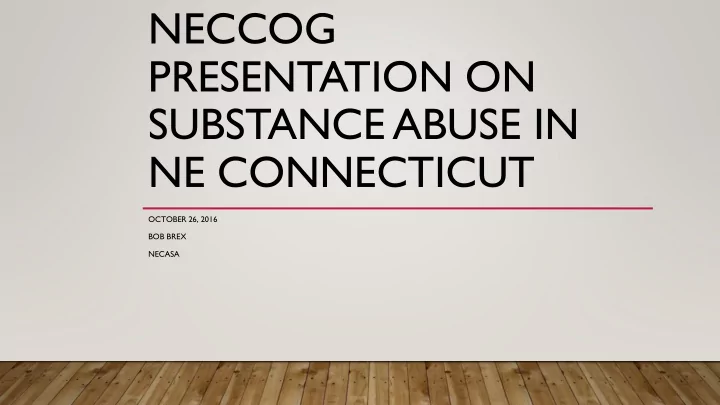

NECCOG PRESENTATION ON SUBSTANCE ABUSE IN NE CONNECTICUT OCTOBER 26, 2016 BOB BREX NECASA
HISTORY OF SUBSTANCE USE IN THE REGION Northeastern Connecticut has the same problems as any city of similar population(some might argue even more of a problem).
CHANGING LANDSCAPE • In 2016: • In 1990: Primary drugs of use/abuse Primary drugs of use/abuse: Opiates/Opioids • Alcohol Alcohol • Tobacco Marijuana • Marijuana T obacco
ISSUES THAT IMPACT THE REGION • Rural Isolation • Lack of Transportation • Poverty • Low Educational Achievement
NECASA’S PLANNING ROLE • NECASA, along with the Eastern Regional Mental Health Board and the SE Regional Action Council make recommendations to the Department of Mental Health and Addiction Services on Regional Priorities.
RECOMMENDATIONS AND FINDINGS • Barriers: • Lack of inpatient availability and ease of access • Lack of Transportation • Travel necessity to get assessments and • Insurance barriers especially to pay for to get treatment inpatient services
EMERGING TRENDS OPIATES/OPIOIDS • • Data compiled by SERAC and NECASA shows an increase in prescription drug misuse (pain medications, downers, uppers, and tranquilizers). Opioid overdoses are on the rise in the region, but at the same time, there has been in increase in the availability of naloxone (NARCAN) • • Factors to consider in addressing the opioid epidemic include: Prescribing practices: even with the new law that was passed last legislative session implementing restrictions to opioid prescriptions, there are several issues of concern. There is increasing evidence that opioids are not the most effective tool for pain management, but they continue to be the first avenue of treatment for many primary care doctors. Due to productivity demands placed on doctors, there is little time to ask about addiction history or brainstorm on other pain management strategies, and follow-up/continuity can be poor at best. There have been numerous community forums on the Opioid Crisis, but as a state and as a region, we still have no coordinated strategic plan for addressing the opioid crisis. We are hopeful that the soon-to-be released plan of the Alcohol and Drug Policy Council will be a significant step in this process. A great deal of public education on addiction is needed; for example, many faith communities are still being told that addiction is a sin or a moral failing, and that with enough faith and prayer, it can be overcome. This sets families and individuals up for failure, and also creates a sense of shame that prevents people from reaching out for help. The failure in many areas of the community to understand addiction as a medical issue also leads to a continued push for criminalization of drug use, which is not only ineffective, but is discriminatory toward the poor and people of color.
YALE STRATEGIC PLAN (CORE) RECOMMENDATIONS • Some of the recommendations presented to the Governor in the Connecticut Opioid REsponse (CORE) Initiative include: • Increase access to high-quality treatment with methadone and buprenorphine: • Strategically expand opioid treatment programs in areas of high need • Promote same-day treatment • Reduce overdose risk, especially among those individuals in highest danger: High-risk individuals include those who have previously overdosed, those leaving prison or treatment, those • taking both opioids and benzodiazepines, and those using injection opioids Intervene in the emergency room to get those who have overdosed into treatment • Distribute naloxone to those who are at high-risk of overdosing • Decrease co-prescription of opioids and benzodiazepines and high doses of opioids •
• Increase adherence to opioid prescribing guidelines, especially for prescribers who prescribe large amounts of opioids: • Increase use of non-opioid treatments for acute and chronic pain • Increase use of the prescription monitoring program Expand professional trainings on screening, brief intervention and referral to • treatment for adult and adolescent patients Increase access to and track the use of naloxone • • Increase data sharing across relevant agencies to coordinate response, especially in response to "outbreaks" of overdoses Increase community understanding of opioid use disorder, the most effective and • evidence-based responses to it and reduce stigma around it Develop communications strategies that raise awareness and promote education on • safe storage and disposal of prescription drugs
Recommend
More recommend